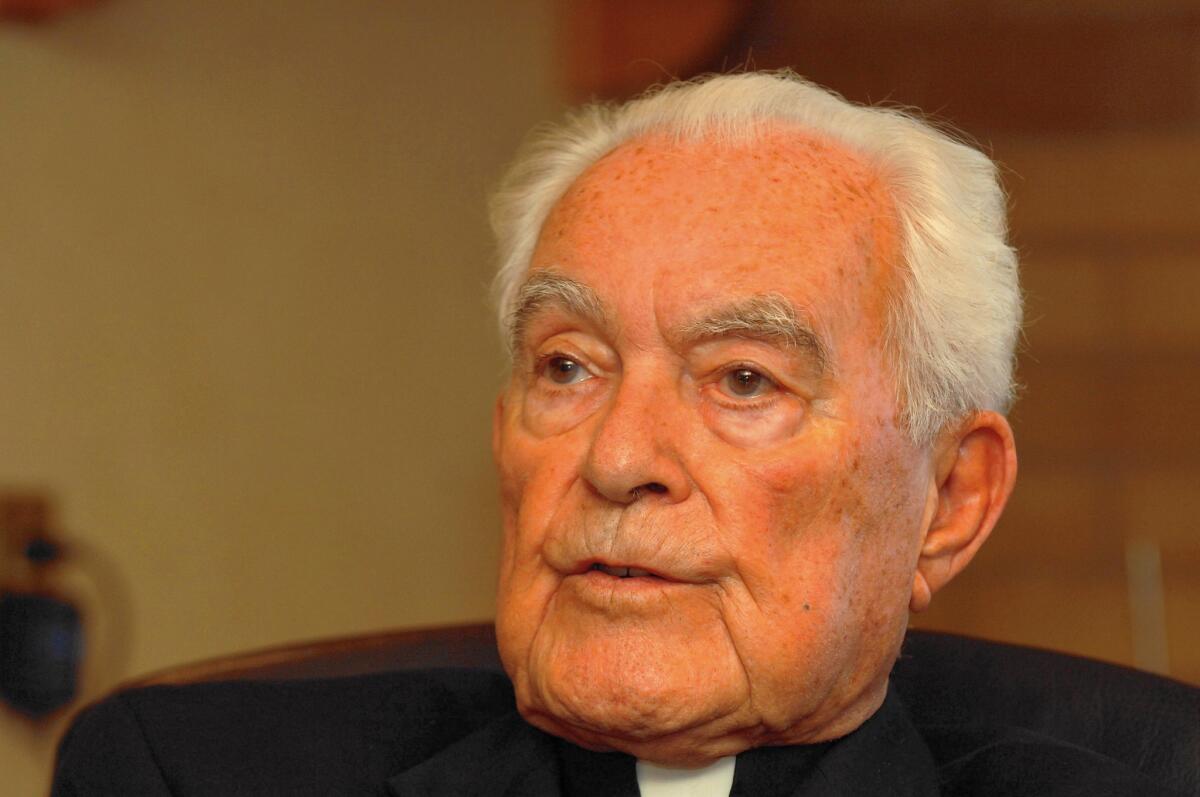Theodore Hesburgh dies at 97; priest turned Notre Dame into academic power

- Share via
The Rev. Theodore Hesburgh transformed the University of Notre Dame into a school known almost as much for academics as for football, even if it meant challenging popes, presidents — and legendary football coaches.
In 35 years at the helm, he helped build Notre Dame into an academic power while championing human rights around the globe, including supporting civil rights and immigration reform and Third World development. He was featured on the cover of Time magazine a decade into his tenure for an article that described him as the most influential figure in the reshaping of Catholic education.
Hesburgh, 97, died late Thursday on the school’s campus in South Bend, Ind., university spokesman Paul Browne said. The cause of death wasn’t immediately known.
“With his leadership, charisma and vision, he turned a relatively small Catholic college known for football into one of the nation’s great institutions for higher learning,” said the Rev. John Jenkins, Notre Dame’s current president.
Hesburgh was born May 25, 1917, in Syracuse, N.Y., and attended Notre Dame as an undergraduate. His goal after coming out of seminary at Holy Cross College in Washington, D.C., was to be a Navy chaplain during World War II. He was instead sent to Catholic University of America in Washington, D.C., to pursue a doctorate. He then returned to Notre Dame, where he quickly rose to become head of the theology department, then executive vice president, before being named president in 1952 at age 35.
His passion for civil rights earned him a spot as a founding member of the U.S. Civil Rights Commission in 1957.
He was a man who wasn’t afraid to challenge authority. As Notre Dame’s executive vice president in 1949, Hesburgh took on powerful football coach Frank Leahy while reorganizing the athletic department. When the Vatican demanded conformity to church dogma, Hesburgh insisted that Notre Dame remain an intellectual center for theological debate. He also famously challenged the record of President Nixon, who fired him from the Civil Rights Commission in 1972.
Hesburgh wrote several books, including one, “God, Country, Notre Dame,” that became a best-seller. Throughout his writings, he shared his vision of the contemporary Catholic university.
“The Catholic university should be a place,” he wrote, “where all the great questions are asked, where an exciting conversation is continually in progress, where the mind constantly grows as the values and powers of intelligence and wisdom are cherished and exercised in full freedom.”
In keeping with that philosophy, Notre Dame underwent profound changes under Hesburgh. Control of the school shifted in 1967 from the Congregation of the Holy Cross priests who founded the school to a lay board. The school ended a 40-year absence in football postseason bowl games and used the proceeds from the 1970 Cotton Bowl to fund minority scholarships. In 1972, Notre Dame admitted its first undergraduate women. Hesburgh called it one of his proudest accomplishments.
“We can’t run the country on men alone, never could,” Hesburgh said 25 years after the first women enrolled. “Women ought to have the same opportunities to develop their talents as men do.”
The school was undistinguished academically when he became president. It had 4,979 students, 389 faculty and an annual operating budget of $9.7 million. When he retired in 1987, Notre Dame had 9,600 students, 950 faculty and an operating budget of $176.6 million. The school’s endowment grew from $9 million to $350 million during his presidency. When he retired, the school was rated among the nation’s most prestigious.
“I’m sure I get credit for a lot of things that I’m part of but not necessarily the whole of,” he said. “We began a great university, and those who followed continued the motion forward.”
Despite the accolades, Hesburgh drew his share of criticism. Some said he spent too much time away from campus pursuing other issues. Others objected to the “15-minute rule” he implemented after students protesting the Vietnam War clashed with police on campus. Under the policy, students who disrupted the university’s normal operations would be given 15 minutes of meditation to cease and desist or would be expelled from school.
As a young priest, Hesburgh’s students included Jose Napoleon Duarte, whose 1984 election as El Salvador’s president set that country on a path to democracy after years of civil war. Hesburgh’s decision to have Duarte give Notre Dame’s 1985 commencement address was met by protests blaming Duarte and the Reagan administration for continued political killings and poverty in the Central American nation. Hesburgh wrote that the presentation of an honorary degree to Duarte didn’t mean the university has to agree with all he was doing.
Hesburgh also supported the university’s decision in 2009 to invite President Obama to speak at commencement. At least 70 bishops opposed Obama’s appearance and Notre Dame’s decision to award him an honorary degree because of the president’s support of abortion rights and embryonic stem-cell research. Hesburgh said universities are supposed to be places where people of differing opinions can talk.
Hesburgh received the Congressional Gold Medal, the government’s highest civilian honor, in 2000.
He is survived by his brother James.
Coyne writes for the Associated Press.
More to Read
Start your day right
Sign up for Essential California for the L.A. Times biggest news, features and recommendations in your inbox six days a week.
You may occasionally receive promotional content from the Los Angeles Times.







